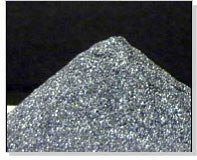 Metal powder can be referred to as as finely divided solid, smaller than 1000 µm in its maximum dimension. Particles are defined as the smallest unit of a powder. The particles of most of the metal powders exist in the sizes of 25 - 200 µm.
Metal powder can be referred to as as finely divided solid, smaller than 1000 µm in its maximum dimension. Particles are defined as the smallest unit of a powder. The particles of most of the metal powders exist in the sizes of 25 - 200 µm.
In majority of cases, the powders are metallic, however in some instances they are blended with other forms such as polymers or ceramics. Powders resemble a behavior, which is intermediate between that of a solid and liquid. Powders flow under gravity to fill die cavities or containers, and hence in this sense they behave like liquids. They can be compressed like a gas, however the compression is generally irreversible, such as the plastic deformation of a metal. Therefore, a metal powder can be easily shaped, with the desirable properties of a solid after processing.
Metal Powder MetallurgyMetal powder metallurgy can be defined as the analysis of the properties of metal powders, including their characteristics, fabrication, and the conversion of metal powders into beneficial engineering components. The three primary steps in the scheme of powder metallurgy are illustrated in the figure below -
The applications of metal powders are quite broad. Moreover, their use in powder metallurgy results in a variety of products, including dental restorations, oil-less bearings, automotive transmission gears, armor piercing projectiles, electrical contacts, nuclear power fuel elements, orthopedic implants, business machine parts, high-temperature filters, aircraft brake pads, etc. Metal powders have also found uses in products, such as paint pigments, rocket fuels, explosives, catalysts, printing inks, and many others.
Due to the rapid increase in the significance of powder metallurgy, metal powders nowadays are being produced in huge quantities. There are several industrial and consumer materials, which are available as powders. These include cereals (grains and flour), minerals, coffee, and metal powders. On a tonnage basis, metal powders are a comparatively small activity when compared to common powders such as cereal and sand. The global consumption of metal powder amounts to approximately one million metric tons/year. The most widely used metal powders are iron and steel, which are followed by aluminum, copper, nickel, tungsten, etc
Metal Powder ApplicationsMetal powders can be made either by gas atomization or grinding and are then classified using dynamic classifiers to attain the precise particle size distribution. To produce the final end-user product, the metal powders are then used in several consolidation processes-
- Extrusion
- Injection molding
- Blending
- Compaction
- Sintering
Characteristics
The main characteristics of metal powders include the particle size distribution, particle shape, the surface condition and the structure of the powder. These impact bulk properties such as reactivity, flow ability, compressibility, porosity and hardenability that all improves as the particle size gets smaller.
The particle size distribution is important to the end user in several ways
- Direct impact on the quality of finished product.
- Simple and easy filling a die.
- Wide distributions permit voids between larger particles to be filled with smaller particles.
- An surplus of fines has negative effects on flow characteristics
- Caking, environmental contamination, pyrophoricity
- Balancing the properties require dynamic process control
